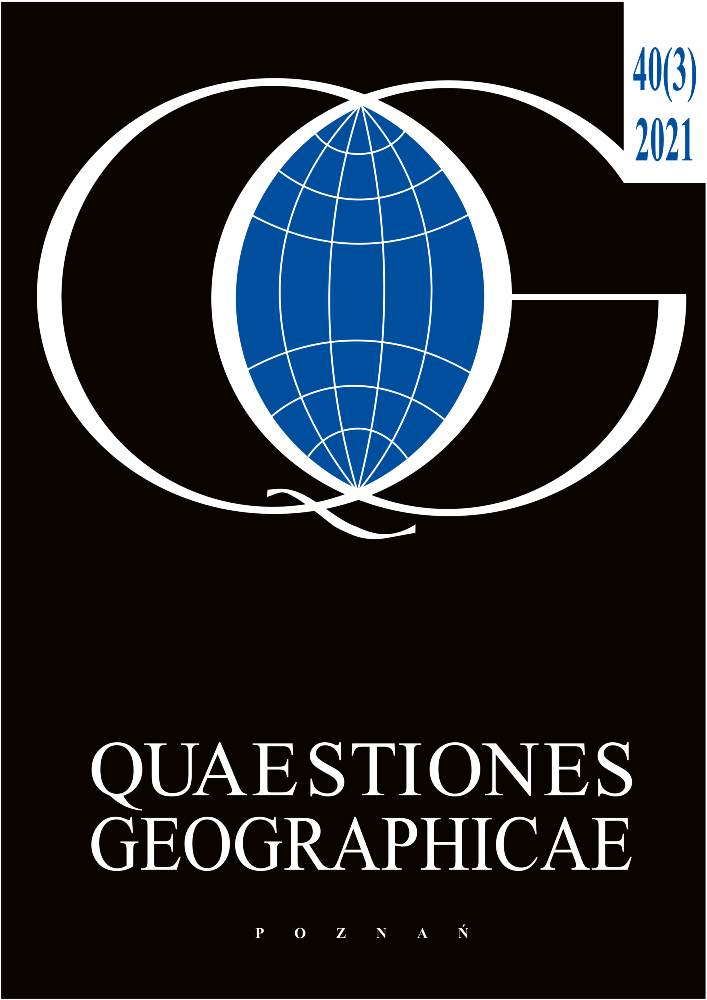Abstract
Despite the large amount of information, including books, articles and pristine images of geotourism, there exists no comprehensive study on the collection and classification of them in Iran yet. In this research, for the modelling of geosite watersheds, 1000 articles were surveyed through library research and the models with the highest frequency of use were identified and analysed among a statistical sample of 451 local papers using the Meta-Analysis method, and then the most efficient ones were identified using Delphi and Analytic Hierarchy Process (AHP) methods. The re- sults of this study showed that while the strengths, weaknesses, opportunities and threats (SWOT), Pralong, Reynard, AHP and Pereira models are in the first to fifth-ranked models with the highest frequency, however, Pralong, SWOT, Reynard, Perira and Comanescu models were considered as the most efficient ones in geosite modelling in Iran.
References
Ahmadabad S., Hasani P., 2006. What is a meta-analysis? Journal of Nursing and Midwifery Faculty, Birjand University of Medical Sciences 3: 15–21.
Abadi Q.A.A., 2013. Meta-political approach: Capacities and gaps. Journal of Social Sciences 71(8): 82–89.
Barba F.J., Tejerina J.R., Rivas V., 1997. Propuesta de un procedimiento para armonizar la valoración de elementos del patrimonio geológico. Zubia 15: 11–20.
Bruschi V.M., Cendrero A., 2005. Geosite evaluation: Can we measure intangible values. Il Quaternario 18(1): 293–306.
Carrión-Mero P., Loor-Oporto O., Andrade-Ríos H., Herrera-Franco G., Morante-Carballo F., Jaya-Montalvo M., Berrezueta E., 2020. Quantitative and Qualitative Assessment of the “El Sexmo” Tourist Gold Mine (Zaruma, Ecuador) as A Geosite and Mining Site. Resources, 9(3), 28. Chingombe W., 2019. Preliminary geomorphosites assessment along the panorama route of Mpumalanga province, South Africa. GeoJournal of Tourism and Geosites 27: 1261–1270.
Coratza P., Giusti C. 2005. Methodological proposal for the assessment of the scientific quality of geomorphosites. Dowling R., Newsome D., 2018. Chapter 17. Geoheritage and geotourism. In Geoheritage (pp. 305–321). Elsevier Inc.
Fassoulas C., Mouriki D., Dimitriou-Nikolakis P., Iliopoulos G., 2012. Quantitative assessment of geotopes as an effective tool for geoheritage management. Geoheritage, 4(3), 177–193.
Gallo P.S., Lynn E., 1981. The variance accounted for in meta-analysis of psychotherapy outcomes: A reply to Willson. American Psychologist 36(10): 1196–1198. DOI 10.1037/0003-066X.36.10.1196.
George Street Research, 2006. Geotourism in Scotland – evaluation and development. Phase 2 – Knockan Crag customer survey. Scottish Natural Heritage Commissioned Report No. 170 (roame no. F04AC104/2).
Ghanavati E., Karam A., Fakhari S., 2012. Review on process geotorism evolutions and models that used in Iran. Geographical Journal of Territory 9(34): 75–91.
Glass G.V., 2000. Meta-analysis at 25. http://www.gvglass.info/papers/meta25.html
Gordon J.E., 2018. Geoheritage, geotourism and the cultural landscape: Enhancing the visitor experience and promoting geoconservation. Geosciences 8(4): 136.
Grandgirard V., 1999. L’évaluation des géotopes. Geologia Insubrica 4: 59–66.
Hose T.A., 1995. Selling the story of Britain’s stone. Environmental Interpretation 10(2): 16–17.
Kubalíková L., 2013. Geomorphosite assessment for geotourism purposes. Czech Journal of Tourism, 2(2), 80–104.
Nasrollahi S.N., Mokhtari H., Seyedein M.S., 2013. Meta-analysis: An approach to integration and evaluation of information science and knowledge research. Journal of Information Processing and Management 29(2): 293–331.
Ólafsdóttir R., Dowling, R., 2014. Geotourism and geoparks – a tool for geoconservation and rural development in vulnerable environments: a case study from Iceland. Geoheritage, 6(1), 71–87.
Panizza M., Piacente S., 1993. Geomorphological assets evaluation. Zeitschrift für Geomorphologie. Supplementband 87: 13–18.
Panizza M., 2009. The geomorphodiversity of the dolomites (Italy): A key of geoheritage assessment. Geoheritage 1(1): 33–42.
Pereira P., Pereira D., 2010. Methodological guidelines for geomorphosite assessment. Géomorphologie: Relief, Processus, Environnement 16(2): 215–222.
Pereira P., Pereira D., Caetano Alves M.I., 2007. Geomorphosite assessment in Montesinho natural park (Portugal). Geographica Helvetica 62(3): 159–168.
Pralong J.P., 2005. A method for assessing tourist potential and use of geomorphological sites. Géomorphologie: Relief, Processus, Environnement 11(3): 189–196.
Ranjbaran M., Zamanzadeh S., Sotohian F., 2020. Geotourism attractions of Hormuz Island, Iran. GeoJournal of Tourism and Geosites 28(1): 232–245.
Reynard E., 2005. Géomorphosites et paysages. Géomorphologie: Relief, Processus, Environnement 11(3): 181–188.
Reynard E., Panizza M., 2005. Geomorphosites: Definition, assessment and mapping. An introduction. Géomorphologie: Relief, Processus, Environnement 11(3): 177–180.
Reynard E., Fontana G., Kozlik L., Scapozza C., 2007. A method for assessing the scientific and additional values of geomorphosites. Geographica Helvetica 62(3): 148–158.
Reynolds J., 2001. Notes to accompany RIGS recording, assessment and designation and notification sheets. In Notes on the UKRIGS Conference.
Sarvestani R.S., 2000. A meta-analysis on the Study of Social Pathology in Iran. Journal of Social Sciences 15: 67–103.
Serrano E., González-Trueba J.J., 2005. Assessment of geomorphosites in natural protected areas: The Picos de Europa National Park (Spain). Géomorphologie: Relief, Processus, Environnement 11(3): 197–208.
Somerville J. 2008. Critical factors affecting the assessment of student learning outcomes: A Delphi study of the opinions of community college personnel. Journal of Applied Research in the Community College, 15(2), 9–19.
Williams P. L., Webb, C., 1994. The Delphi technique: a methodological discussion. Journal of advanced nursing, 19(1), 180–186.
Wolf F.M., 1986. Meta-analysis: Quantitative methods for research synthesis. Sage.
Yang B., 2002. Meta-analysis research and theory building. Advances in Developing Human Resources 4(3): 296–316.
Zanganeh Asadi, M.A., Amirahmadi A., Shayan Yeganeh A.A., 2018. mechanism of protection of proposed Geopark West of Khorasan Razavi by brilha method. Geography and Planning, 22(63), 117–137.
Zouros N., 2005. Assessment, protection, and promotion of geomorphological and geological sites in the Aegean area, Greece. Géomorphologie: Relief, Processus, Environnement 11(3): 227–234.
Zouros N.C., 2007. Geomorphosite assessment and management in protected areas of Greece Case study of the Lesvos island–coastal geomorphosites. Geographica Helvetica 62(3): 169–180.

